
Xing (邢窑) wares
Xing white wares were much sought after during the Tang Dynasty. This was recorded in the ancient historical text (国史补) by Li Zhao (李肇) who commented that Xing white wares from Neiqiu (内丘) were used by the rich and poor (内丘白瓷瓯, 端溪紫石砚, 天下无贵贱通用之). The characteristic silver-like white of fine Xing ware (若邢瓷类银, 越瓷类冰) was noted by Lu Yu (陆羽) in his treatise on tea (茶经).
Xing kiln was one of the earliest production site for white wares in Northern China. Xing kiln started production during the late Northern Dynasty period. It reached peak production during the Mid Tang period and declined from the late Tang period. During the Tang Dynasty, it produced the best white wares with elegant form and snow/silver white glaze but there were also large amount of poorer quality white wares to cater to the demand of the common folks. Since the Shang period, porcelains produced were essentially greenwares. The popularity of Northern China white glazed wares during the Tang Dynasty established the following porcelain production trend: green glazed wares of the South and white wares of Northern China (南青北白).
The production of white glaze ware is a very important milestone in the history of Chinese Ceramics. White is the ideal colour background for the drawing of motifs on porcelains. The success of the Cizhou iron brown/black motifs and subsequent blue and white would not be possible without the invention of white glaze porcelain.
Location of Xing kilns
It has now been established that Xing kilns were located in present day Lincheng (临城), Neiqiu (内丘) and Xingtai (邢台). Chinese archaeologists had tried to locate the Xing kilns for many years. The first breakthrough only materialised in 1980. Xing snow white-like sherds were finally found in Qicun (祁村) in Lincheng county (临城). From 1982 to 1985 more than 20 kiln sites that produced Xing white wares were discovered in Neiqiu county (内丘), Lincheng and Xingtai.

More importantly, in 1985, samples with the incised ying (盈) mark which is closely associated with Xing white wares were finally found in Neiqiu. In 2003, more sherds with ying mark were also excavated in Xingtai.
Sherds mainly cover boxes and jars bearing hanlin (翰林) mark were also found in Neiqiu and Xingtai. More than 10 pieces bearing Da ying (大盈) mark were excavated in Xingtai. The mark was incised on the disc like base of bowls. There are dated earlier than those with yin mark which have yu-bi base (玉壁底). There were also small number of sherds of bowls with the guan (官) mark found in Xingtai. Visually they are similar to those from the Ding kiln. They are dated to late Tang period.
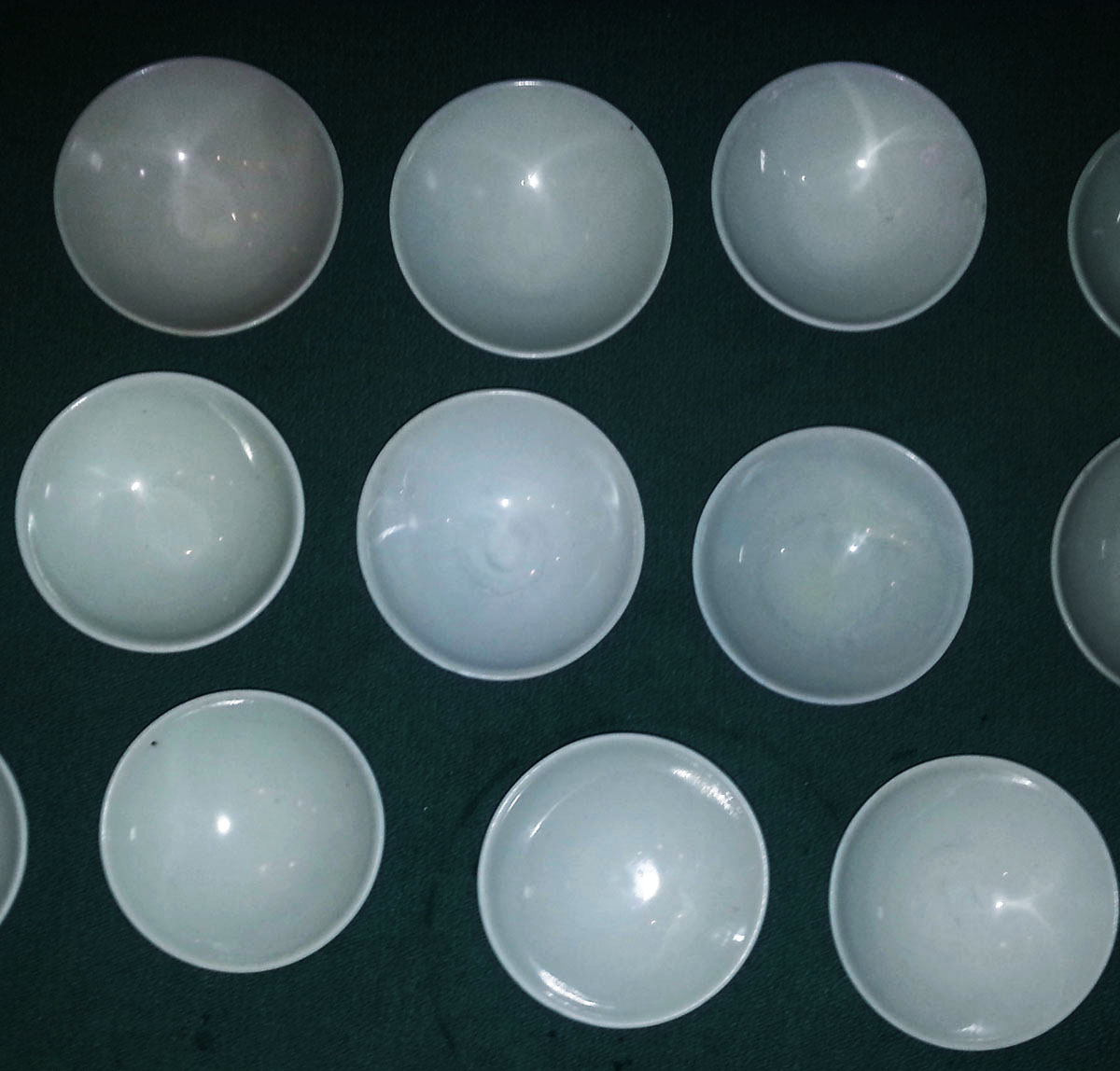
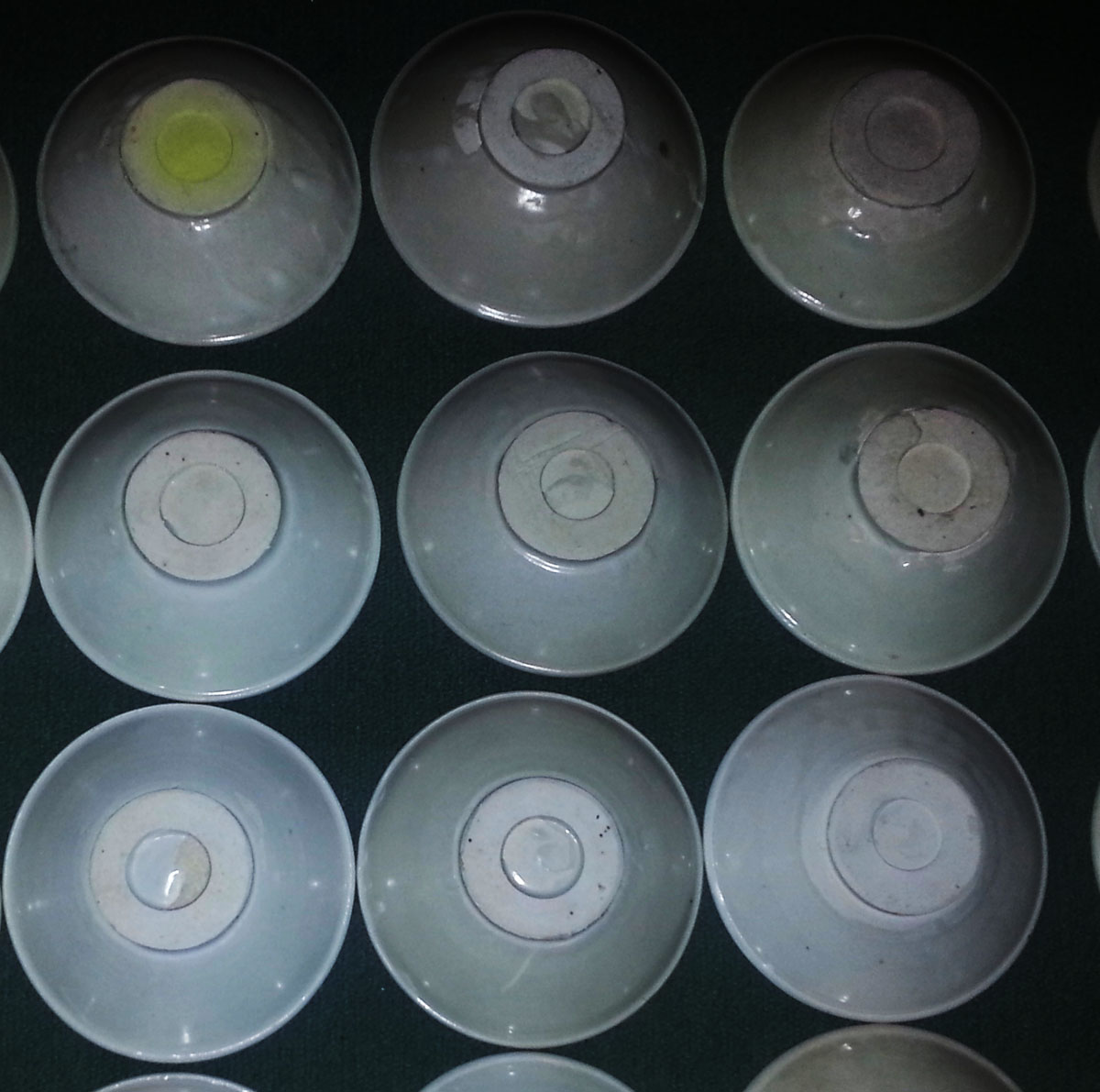
Tang Xing Yi-bi base bowls recovered from Musi river in Palembang Indonesia
In 2013 some Xing plates and ewers surfaced in the Vietnamese antique market. They came together with some Changsha and Yue bowls. They came from an unknown wreck in Central Vietnam. I saw a piece of fragment of the Yue bowl with incised character Qian (乾) and very likely a portion of the character Heng (亨). It is very likely the reign mark Qian Heng (used form A.D 917 to 925) used by the first king of the Nanhan state of the 5 Dynasties period. The changsha ewers from this wreck has more elongated form and longer spout. There are also Changsha wares with white glaze and green/brown splashes. Such Changsha wares were also found in a 5 Dynasties ancient pier site in Changsha. Some Ceramics experts from the Hebei museum have viewed the below sherds and confirmed that they are from Xing kiln. Generally, the paste of Ding wares of the same period are more fine and compact.
|
|
|
|
|
Xing Sherds samples from Wreck in Central Vietnam |
|
|
|
| Three examples of 5 Dynasties Xing wares found in Wreck in Central Vietnam | |
Xing wares with ying mark were found in many areas such as Xian (西安), Beijing (北京), Hangzhou (杭州), Chifeng (赤峰), Shanxi (山西) and etc. They consisted of bowls, plates, jars, ewers, pillows, washers, cover boxes and cup with stands. It is now a generally accepted view that those wares with the ying and hanlin mark were made for the Imperial palace and stored in the premises called Bai Bao Da Ying Ku (百宝大盈库) which also held other precious objects. However, some Xing wares with the Ying and Hanlin marks were also found in graves of the rich especially in the neighbouring Shanxi (山西) province. Interestingly they usually have some manufacturing defects. This appears to suggest that the defective pieces were not destroyed but sold to the rich who still treasured them.
Types of Wares made during various phases of Production
From 1988 to 1992, the Xingyao archaeological team excavated 3 kiln sites, one in Neiqiu and two in Lincheng. Numerous artifacts from the Sui to Jin period were discovered. It provided enormous help in the dating of Xing wares from different phases of production.
Archaeological excavations revealed that Xing kilns in Xingtai, Neiqiu and Lincheng initially produced some green wares during the late Northern Dynasty period. During this period, the potting is thick and the paste has coarse grains and greyish yellow in tone. The glaze is greenish or yellowish green in tone.
During the Sui period, besides greenwares, white wares were produced. The white wares consisted of those which coarse and fine. The coarse type has greyish white paste cover with a layer of white slip before glazing. The fine one has more fine grained and more whitish paste. Hence, there is no need to add a layer of white slip.
Below photo showed how the bowls were placed and stacked in the firing chamber. Stacks of bowls were arranged around a prop. The bowl at the bottom was placed on a ring shaped setter. The bowl on the interior is separated by a 3-prongs spur. Usually, another one to 2 layers of the props were added on top of the first prop to allow for more vessels to be stacked. Vessels such as ewer or jar could be placed on the top of the highest prop. No saggar was used to protect the vessel using such stacking method. There were limited use of saggars to contain fine quality vessels to avoid direct contact with the flames.
Among the artifacts from the Sui period, the most spectacular discovery was translucent white glaze sherds (透影白瓷) found during the excavation of the site in Chengguan (城关) in Neiqiu. They were remnant fragments of small vessels such as cups, bowls and plates. The potting of some of the cups and bowls is very thin and delicate with a amazing thickness of only 0.7 to 1 mm. However, production of such wares mysteriously ceased after Sui period.
During the Early Tang phase, besides green and white wares, black, yellow glaze and sancai wares were also produced. Saggars were used to protect the vessels during firing. Below shows the saggars used to place the fine Xing bowl or plate. There are also cylindrical shape saggars to contain other type of vessels such as jars, vases and ewers.
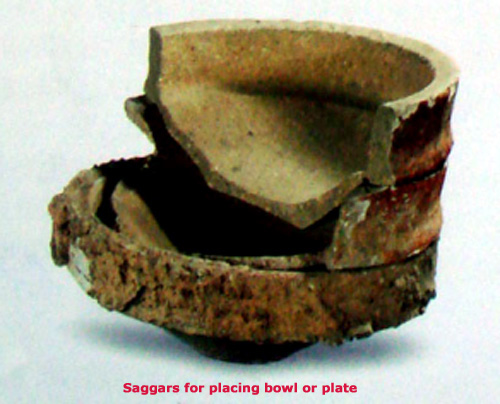
Mid Tang was the peak production phase for white glaze wares but other types such as black, yellow, brown and sancai glazed wares were still produced. In terms of varieties and quality of the vessels, this was the golden period for Xing wares. Many of the items such as bowls, cups and plates were thinly potted and uses shapes found in Middle East gold and silver wares. This was a trend not unique to Xing but also found in famous wares from Yue and Yaozhou kilns.
The late Tang period showed a decline in production in terms of volume and the varieties of vessels. White wares and black wares were the main glazed type produced. Some Sancai wares continued to be produced even till the Song period. Similar trend persisted into the 5 Dynasty period.
It must be stressed that besides the fine white wares, Xing kilns also produced many coarse white bowls/plates and also ewers, pillows and etc. For the fine ware, each occupied one saggar. Hence, there is no spur marks on the inner bottom of the bowls/plates. However for the coarse bowls/plates, they are covered with a layer of white slip with lower area of the outer wall which are not glazed. They used the stacking method of firing and the 3 spur marks left by the 3 prongs spur still visible on the inner bottom of the vessels.
In the past, it was generally thought that Xing wares ceased production after 5 Dynasty. But archaeological evidence showed that porcelain production continued. In some sites such as those in Lincheng, production was substantial during the Song/Jin period. The white wares during the Song period showed similarity to those from the Ding kiln which represented the best of Song white wares. No major excavations have yet been carried out on those site. Hopefully, with extensive excavations in the future, a clearer pictures of Xing products during the Song/Jin period would emerged.
Excavations revealed that Xing kilns produced substantial quantity of sancai wares, including bowls, plates, cups, censers, jars and etc. Most of the vessels were of practical usage. In comparison, many of the products from Gongxian (巩县) and Xian kilns were produced for burial purposes. The paste of sancai vessel from Xing kiln is usually reddish or yellowish brown in tone after firing. A white slip is applied over the body before firing of the unglaze ware. Lead coloured glazes were then applied on the vessel and fired at a lower temperature of about 900 degree centigrade. The glaze of the sancai wares is glassy and usually has fine crackles.
Xing wares as an Export item
Xing ware was a significant export porcelain from Mid Tang to 5 Dynasty period. Xing, together with Yue and Changsha wares were exported through the overland silk road and the maritime trade route to Asia and beyond. Sherds of Xing, Yue and Changsha wares were excavated from ancient sites as the far as Iraq and Egypt.
Some Xing white wares were also found in the Belitung shipwreck which carried mainly Changhsa wares and also some Yue greenwares, Ding and Gongxian white /blue and white wares. The Belitung shipwreck is dated to A.D. 826 based on a Changsha bowl with a date of 2nd year of Baoli. There were also some vessels with white/green glaze. Some of the bowls have the incised Ying mark. According to some Chinese experts who have examined some of the items, at least some of them were very likely products of Xing kiln. (Recent tests on eight samples confirmed that they were from the Gongxian region. This raised interesting questions such as whether Ying mark which is associated with Xing kiln, was also incised on the outer base of similar products produced in other kilns.)
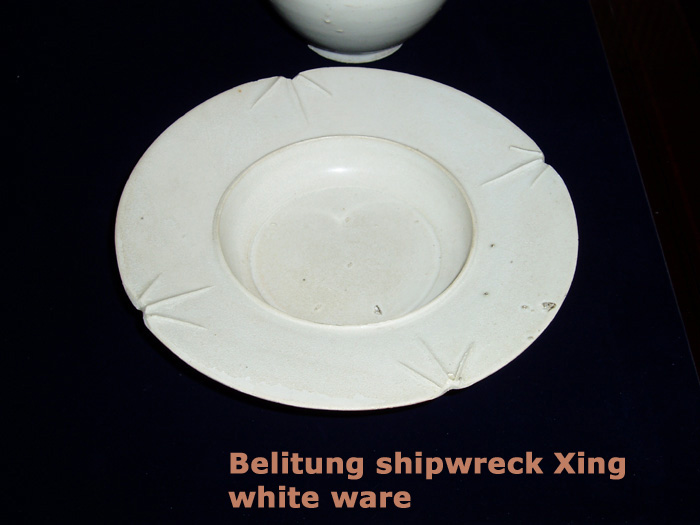
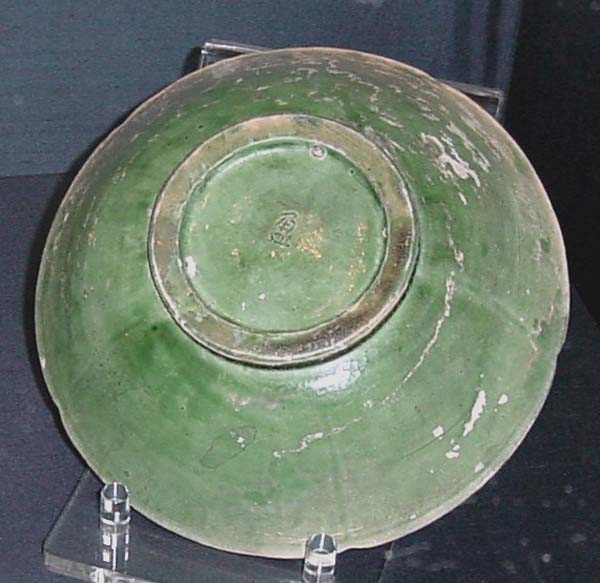
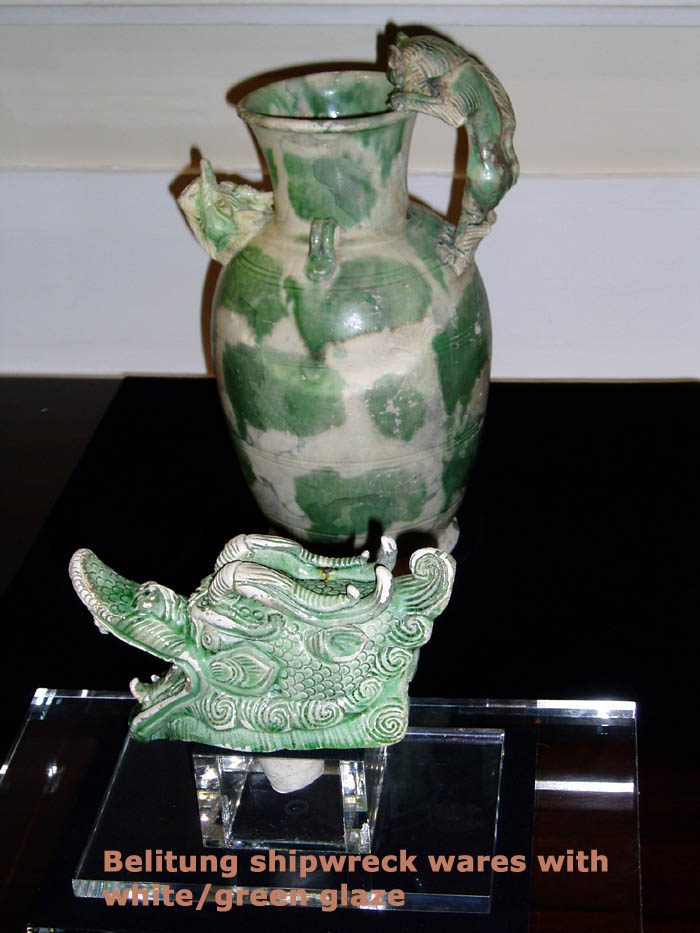
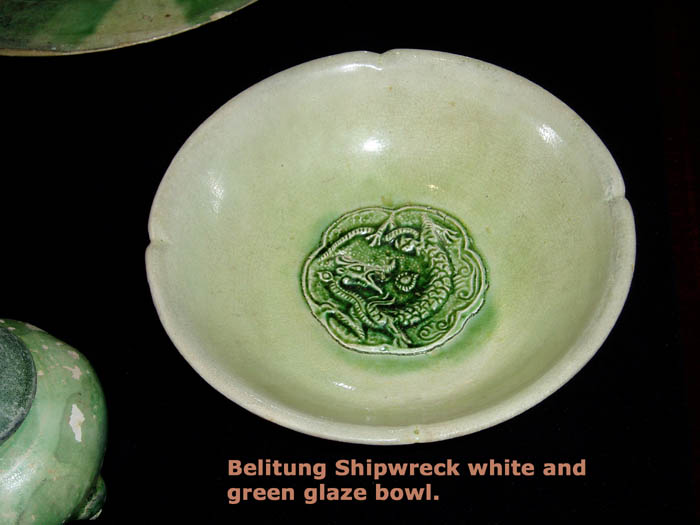
Written by : NK Koh (10 May 2010)
References:
1. 千年邢窑 - 赵庆刚, 张志忠 主编